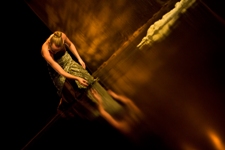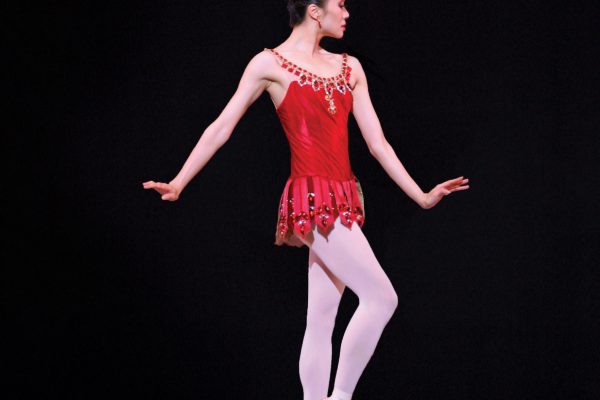Every Dancing on the Edge Festival needs at least one really edgy show to justify the festival’s name, and this twenty-third edition had two. I didn’t catch everything over the ten, mostly rainy days of dance, partly because with venues spread across the city, it was hard to fit everything in. But I’m particularly glad I saw Susanna Hood’s “She’s gone away” and Benjamin Kamino’s “Nudity.Desire”. These two shows were not just edgy, but smart, too.
Hood’s solo, “She’s gone away”, was presented at Scotiabank Dance Centre, and was one of five full-length shows. In this darkly dramatic psychological thriller from 2006, the Montreal/Toronto-based artist bombards the audience with an array of characters and animal personas. One is an easily startled, squeaky voiced creature on tiptoe; another is heavy, gorilla-like, earthbound. Yet another moans about “dark charcoal brown feelings”, running a hand down her body to her groin. At times, Hood seems to contain within herself a whole horror movie. This is partly because of her ability to quick-change into so many different and disturbing states of mind and partly thanks to an amazing sound design by Nilan Perera that features vocal distortion. In one frightening scene, a monster-voice — thick and slow — appears to be spewing live out of Hood’s mouth (she wears a wireless mic). Hood is also well supported by designer Lorenzo Savoini, whose subtly off-kilter set includes a chair with two short legs so it stands at an angle.
Over the fifty-five minutes of this unique dance-as-psychotherapy session, we slowly realize Hood has been unearthing the deep, distorted memories of a child who witnessed her parents having sex. Or maybe the child is now a grown woman, struggling to be whole while a part of her psyche still reels from what she saw.
The other smart, edgy child was Benjamin Kamino whose “Nudity.Desire” opened the fifth of six mixed bills at the Firehall Arts Centre, the festival’s home base. Kamino, another Montreal/Toronto-based artist, was dancing nude, free and easy, on a white paper floor as we entered. He continued long after we were all seated, and when he followed this by standing still for what also seemed a long time, staring ahead, I was ready to drift off – but then a shiny emerald green fluid erupted out of his mouth and poured down his chest and legs, spattering on the paper like blood. The whole audience seemed to wake up and take notice.
In “Nudity.Desire”, a wild man persona — long, frizzy hair, no clothes, completely unselfconscious – was placed within the highly theatrical, intellectual form of performance art. Kamino’s childlike man vaguely imitates the high-art poses of ballet or expressive modern dance with no idea of their meaning or evolution. He picks up a felt pen and with a kind of random physical force — it’s as if the pen, and not him, knows what to do – draws a tree on the paper backdrop. Sounds push past his lips, but make no sense, and they surprise him. He doesn’t appear to know the meaning of anything – not of clothes (which he puts on at one point) or speech, not of dance or painting. Yet art — the will to create — lies inside him, and keeps erupting.
Some of us had an impromptu audience chat after “Nudity.Desire” as we waited for the stage to be cleared for the next piece. Together we figured out Marie Chouinard might be a big influence on Kamino, so it was no surprise to then learn from the program note that he guests with her company. The note also includes a brief quote from Slavoj Zizek’s “The Plague of Fantasies” about the “objet petit a” that proved impossible for us to unpack; Kamino’s own explanation of beginning his research with the idea of a nude body “absent of content”, and moving on to “its small fights for understanding”, was more helpful.
There was a formal, well-attended audience talk after the Festival’s opening night show, “Quiet” by Arkadi Zaides from Tel Aviv, the only international work. The hour-long dance was performed by Zaides and three other men. Knowing from the press release that the cast was made up of both Israelis and Palestinians made watching this choreography of wary passivity and angry gestures poignant, though the men’s mixed movement styles didn’t cohere as a whole (the free-wheeling capoeira style of one, for instance, often jarred next to the more contained movement of the others). Yet much in this work communicated strong and clear: the hunched postures, the backing away, the jabbing arms and fingers, and the kneeling, with foreheads to the floor. The audience applause at the end was overwhelming.
Another moving full-length piece, this time at the Roundhouse Community Arts and Recreation Centre, was Karen Jamieson’s “Collision”. With five professional, twelve community and four First Nations performers, and the whole ground floor of the Roundhouse as a stage, “Collision” was a site-specific treat and classic Jamieson. The story behind the work centres on the Roundhouse, which was once the western terminus of the Canadian Pacific Railway and sits on territory that is the ancestral home of the Squamish Nation. The Squamish Family Dancers, led by Chief Ian Campbell, made only a few, but key, appearances, when they embodied their dance — their culture — with an unforced but charismatic presence.
Another site-specific dance-as-history-lesson was “Ashes on the Water” by Quelemia Sparrow and Noah Drew of Neworld Theatre, a podplay that took audiences on a journey through historic Gastown to a Burrard Inlet beach. Travelling in twos, we wore headphones and shared an iPod in order to listen to a play about Vancouver’s Great Fire of 1886. Strong imagery and sound effects alone convincingly evoked the catastrophic fire that happened where we ourselves were now walking so many years later. “Ashes on the Water” ended, in silence, as we sat on a log and watched a small group of women sway gently in the water and then roll in the sand, dressed in long dresses and wading shoes. The movement was by Michelle Olsen and Kimberly Tuson.
Donna Redlick’s “The Place Between” also took place outside a traditional theatre space: this time in the Firehall’s upstairs studio. Twenty or so audience members were allowed in at a time, given a mirror and instructed to use it to help see the performers whenever needed. That simple prop meant each viewer was actively engaged in this thoughtful dance about the nature of reality, which began with Redlick writing on the large studio mirror: “The world is what you perceive.” In my mirror, which I used when Redlick, Salome Diaz and Jeannine Miller moved to the back of the room, I saw glimpses of their bodies, of other audience members and of myself.
Redlick wasn’t the only one to present dance-as-philosophical speculation; in some ways, Barbara Bourget’s short solo on Edge Three, “Happiness”, also opened up thoughts about the nature of reality. It was created for and danced by Diaz, who has trained in butoh and contemporary dance with Bourget and Jay Hirabayashi’s Kokoro Dance since 1993. Her performances with the company are always fuelled by remarkable inner commitment. Here, to a minimal score by Iceland-based duo, Jonsi and Alex, Diaz weaves her arms and torso, mostly from one small part on the stage, in an outwardly straightforward dance mysteriously filled with presence.
On Edge Six, the 605 Collective also had presence, but of a different kind, in “Inheritor EP”, choreographed by the Collective’s Lisa Gelley, Shay Kuebler and Josh Martin, who performed with guests Justine Chambers and David Raymond. This gang of five reminded me of the cool kids at high school: lots of attitude, little heart, at least in the three sections we saw of the work-in-progress (heart might yet be revealed). Together they roll on the floor or take hard-edged kamikaze poses — torsos skewed to the side, bums often in the air, arms stretched out and fingers wide. The quiet section when the group is tossed back and forth across the stage as if blown by the wind was impressive, as was most of the unison dancing; when they work together so tightly it’s as if they share one headspace.
I’ll end my tour through Edge 2011 with three additional highlights from the mixed bills. First, the trio of witches – Alison Denham, Bevin Poole and Kim Tuson — kicking up their black Victorian skirts in Tara Cheyenne Freidenberg’s spooky work-in-progress, “Highgate”. Second, Meredith Kalaman’s gentle evocation of Noam Gagnon’s crash-and-burn aesthetic in “Through the Waters”, a commissioned solo. Kalaman, sensible girl, wore black knee pads as she tossed herself through the tightly contained choreography: on her hands and knees, blonde hair flying, head back and mouth gaping open, or stretched out on her stomach, face to the floor. Third, Rob Kitsos’ mobile face in “Barego” as he lip-syncs to a voice over of Jack Lemmon in Glengarry Glen Ross, from a scene in which the American actor brags about pulling off a business deal. That’s the image with which I’ll sum up this edition of Dancing on the Edge: a dancer’s face full of brashness and hope.
Tagged: Contemporary, Festival, Performance, Site-Specific, BC




